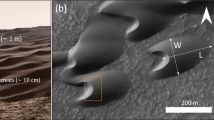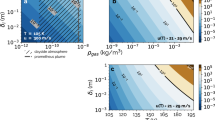Abstract
Linear sand dunes cover the equatorial latitudes of Saturn’s moon Titan and are shaped by global wind patterns1,2,3. These dunes are thought to reflect present-day diurnal, tidal and seasonal winds1,3,4,5,6, but climate models have failed to reproduce observed dune morphologies with these wind patterns4,6. Dunes diagnostic of a specific wind7,8 or formative timescale9,10,11 have remained elusive3,5,12. Here we analyse radar imagery from NASA’s Cassini spacecraft and identify barchan, star and reoriented dunes in sediment-limited regions of Titan’s equatorial dune fields that diverge by 23° on average from the orientation of linear dunes. These morphologies imply shifts in wind direction and sediment availability. Using a numerical model, we estimate that the observed reorientation of dune crests to a change in wind direction would have taken around 3,000 Saturn years (1 Saturn year ~ 29.4 Earth years) or longer—a timescale that exceeds diurnal, seasonal or tidal cycles. We propose that shifts in winds and sediment availability are the product of long-term climate cycles associated with variations in Saturn’s orbit. Orbitally controlled landscape evolution—also proposed to explain the distribution of Titan’s polar lakes13—implies a dune-forming climate on equatorial Titan that is analogous to Earth.
This is a preview of subscription content, access via your institution
Access options
Subscribe to this journal
Receive 12 print issues and online access
$259.00 per year
only $21.58 per issue
Buy this article
- Purchase on Springer Link
- Instant access to full article PDF
Prices may be subject to local taxes which are calculated during checkout



Similar content being viewed by others
References
Lorenz, R. D. et al. The sand seas of Titan: Cassini RADAR observations of longitudinal dunes. Science 312, 724–727 (2006).
Lorenz, R. D. & Radebaugh, J. Global pattern of Titan’s dunes: Radar survey from the Cassini prime mission. Geophys. Res. Lett. 36, L03202 (2009).
Radebaugh, J. et al. Dunes on Titan observed by Cassini Radar. Icarus 194, 690–703 (2008).
Barnes, J. et al. Spectroscopy, morphometry and photoclinometry of Titan’s dune fields from Cassini/VIMS. Icarus 195, 400–414 (2008).
Rubin, D. M. & Hesp, P. a. Multiple origins of linear dunes on Earth and Titan. Nature Geosci. 2, 653–658 (2009).
Tokano, T. Relevance of fast westerlies at equinox for the eastward elongation of Titan’s dunes. Aeolian Res. 2, 113–127 (2010).
Bagnold, R. A. The Physics of Blown Sand and Desert Dunes Vol. 265 (Chapman and Hall, 1941).
Rubin, D. M. & Hunter, R. E. Bedform alignment in directionally varying flows. Science 237, 276–278 (1987).
Rubin, D. & Ikeda, H. Flume experiments on the alignment of transverse, oblique, and longitudinal dunes in directionally varying flows. Sedimentology 37, 673–684 (1990).
Ewing, R. C., Kocurek, G. & Lake, L. W. Pattern analysis of dune-field parameters. Earth Surf. Process. Landf. 31, 1176–1191 (2006).
Ewing, R. C., Peyret, A. P. B., Kocurek, G. & Bourke, M. Dune field pattern formation and recent transporting winds in the Olympia Undae Dune Field, north polar region of Mars. J. Geophys. Res. 115, E08005 (2010).
Savage, C. J., Radebaugh, J., Christiansen, E. H. & Lorenz, R. D. Implications of dune pattern analysis for Titan’s surface history. Icarus 230, 180–190 (2014).
Aharonson, O. et al. An asymmetric distribution of lakes on Titan as a possible consequence of orbital forcing. Nature Geosci. 2, 851–854 (2009).
Kocurek, G. & Ewing, R. C. in Sedimentary Geology of Mars (eds Grotzinger, J. P. & Milliken, R. E.) 151–168 (SEPM Special Publication 102, 2012).
Lucas, A. et al. Growth mechanisms and dune orientation on Titan. Geophys. Res. Lett. 41, 6093–6100 (2014).
Parteli, E. J. R., Durán, O., Tsoar, H., Schwämmle, V. & Herrmann, H. J. Dune formation under bimodal winds. Proc. Natl Acad. Sci. USA 106, 22085–22089 (2009).
Allen, J. R. L. Reaction, relaxation and lag in natural sedimentary systems: General principles, examples and lessons. Earth-Sci. Rev. 10, 263–342 (1974).
Lucas, A. et al. Insights into Titan’s geology and hydrology based on enhanced image processing of Cassini RADAR data. J. Geophys. Res. 119, 2149–2166 (2014).
Radebaugh, J. et al. Linear dunes on Titan and Earth: Initial remote sensing comparisons. Geomorphology 121, 122–132 (2010).
Kocurek, G. & Ewing, R. C. Aeolian dune field self-organization—implications for the formation of simple versus complex dune-field patterns. Geomorphology 72, 94–105 (2005).
Tsoar, H. Linear dunes—forms and formation. Prog. Phys. Geogr. 13, 507–528 (1989).
Zhang, D., Narteau, C., Rozier, O. & Courrech du Pont, S. Morphology and dynamics of star dunes from numerical modelling. Nature Geosci. 5, 463–467 (2012).
Kocurek, G. & Lancaster, N. Aeolian system sediment state: Theory and Mojave Desert Kelso dune field example. Sedimentology 46, 505–515 (1999).
Griffith, C. A. et al. Possible tropical lakes on Titan from observations of dark terrain. Nature 486, 237–239 (2012).
DeMenocal, P. et al. Abrupt onset and termination of the African Humid Period: Rapid climate responses to gradual insolation forcing. Quat. Sci. Rev. 19, 347–361 (2000).
Werner, B. T. & Kocurek, G. Bed-form dynamics: Does the tail wag the dog? Geology 25, 771–774 (1997).
Lancaster, N. et al. Late Pleistocene and Holocene dune activity and wind regimes in the western Sahara Desert of Mauritania. Geology 30, 991–994 (2002).
Burr, D. M. et al. Fluvial features on Titan: Insights from morphology and modeling. Geol. Soc. Am. Bull. 125, 299–321 (2013).
Hayes, A. et al. Hydrocarbon lakes on Titan: Distribution and interaction with a porous regolith. Geophys. Res. Lett. 35, L09204 (2008).
Ewing, R. C. & Kocurek, G. Aeolian dune-field pattern boundary conditions. Geomorphology 114, 175–187 (2010).
Acknowledgements
Comments from C. Newman and T. Farr greatly improved our manuscript. This research was supported by NASA through the Cassini Data Analysis Program by grant NNX14AD52G to R.C.E. and A.G.H. A.L. thanks the French Space Agency (CNES) for its support. We thank C. McCormick, D. Parker and S. Troy at the University of Alabama and C. Ballard from University of California at Berkeley for assistance with mapping.
Author information
Authors and Affiliations
Contributions
R.C.E. and A.G.H. contributed to the design, research, analysis and writing of the study. A.L. contributed the de-noised Titan data and manuscript editing.
Corresponding author
Ethics declarations
Competing interests
The authors declare no competing financial interests.
Supplementary information
Supplementary Information
Supplementary Information (PDF 4302 kb)
Rights and permissions
About this article
Cite this article
Ewing, R., Hayes, A. & Lucas, A. Sand dune patterns on Titan controlled by long-term climate cycles. Nature Geosci 8, 15–19 (2015). https://doi.org/10.1038/ngeo2323
Received:
Accepted:
Published:
Issue Date:
DOI: https://doi.org/10.1038/ngeo2323
This article is cited by
-
Structure and chronology of a star dune at Erg Chebbi, Morocco, reveals why star dunes are rarely recognised in the rock record
Scientific Reports (2024)
-
Geochemical features and their implication of provenances of riparian dunes in the northern China deserts
Journal of Geographical Sciences (2023)
-
Aeolian sediment transport on Io from lava–frost interactions
Nature Communications (2022)
-
Numerical simulation of wind field and sand flux in crescentic sand dunes
Scientific Reports (2021)
-
Titan as Revealed by the Cassini Radar
Space Science Reviews (2019)



